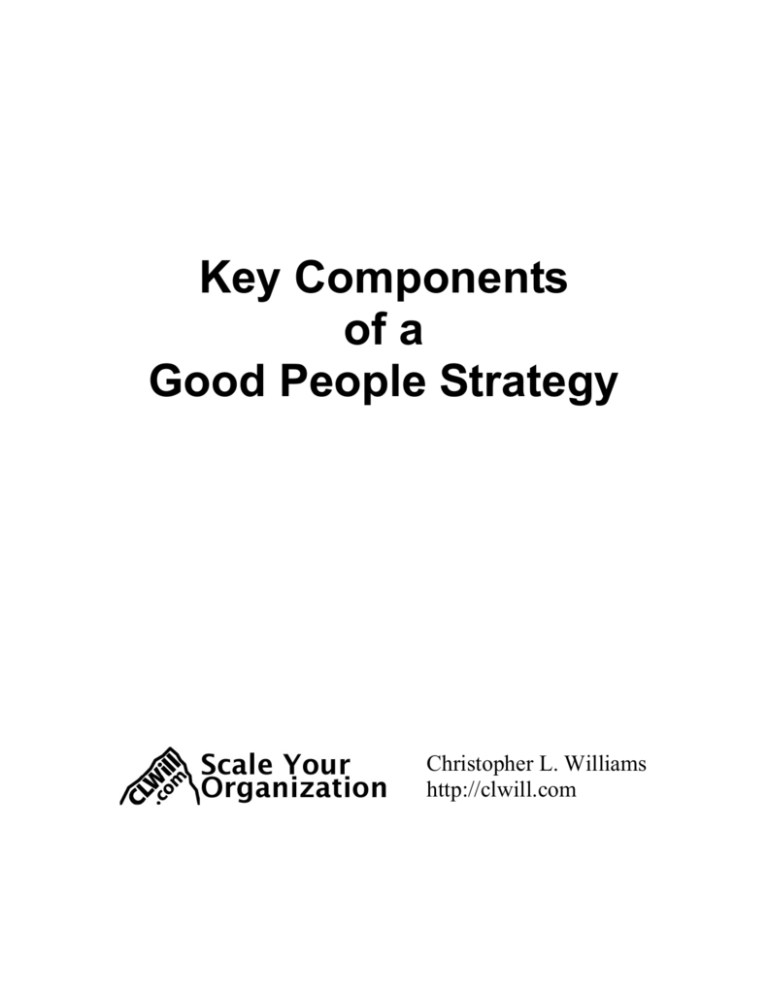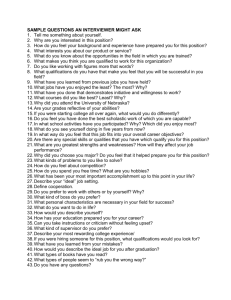Key Components of a Good People Strategy
advertisement

Key Components of a Good People Strategy Christopher L. Williams http://clwill.com Key Components of a Good People Strategy A “people strategy” is a strategic document that outlines the company’s approach to and relationship with its employees. It is NOT a policy manual (although you need one of those too); it should not be that deep or tactical. The point of a people strategy is to make sure all people in a supervisory position understand the company’s overall relationship with employees. Armed with this information, supervisors can make the wide range of judgment calls that fall outside the policy manual. They are often called upon to make these decisions at those times where a rigid policy is neither available nor even appropriate. Examples include when hiring a new employee, when faced with a disciplinary issue outside the scope of company policy, or when trying to reward a particularly notable performance. Having a good people strategy will help to insure that they make a decision consistent with company strategy and other managers in the company. A people strategy also aids in times of scarce resources. A company armed with a good people strategy can make the kind of tradeoffs necessary without jeopardizing their employee relationships. If, for example, a company has decided in advance that it is willing to trade benefits for wages (or vice versa) everyone knows what needs to happen when budget cuts need to happen. So what makes up a good people strategy? While it should consider all aspects of the employer/employee relationship, it does not need to be a complete detailed roadmap. The key is that it is high-level enough to provide broad guidance, yet specific enough to be more than simply platitudes. Some sample topics and/or tradeoffs that a good strategy might address are: • Staffing levels. Does the company prefer to have ready labor capacity or to run leaner and only add people on demonstrated need? Key decision points are: How much time does it take to bring on new people, and how critical are capacity issues? • Compensation strategy. Does the company prefer to keep compensation expenses at the minimum levels to support required staffing or would it prefer to be considered more generous in the industry or community? Key decision points are: How important are compensation costs to the overall company strategy, how difficult is the industry to recruit within, and how important compensation is in the turnover strategy (see below). • Wage/Benefit tradeoffs. Does the company prefer to pay higher wages and keep benefits at the lowest possible level or vice-versa? Key decision points are: What is the preference (often based on age) of the workforce, and how important are these factors in the recruitment of new employees. Copyright 2006 – Chris Williams http://clwill.com Key Components of a Good People Strategy Page 2 • Hiring standards. Does the company strictly hire only the best and brightest regardless of cost, or hire sufficient to meet the needs at the time at the lowest reasonable cost? Key decision points are: How much do top quality people have an impact on the business and how important are costs to the bottom line? • Performance standards. Does the company have a strict “bottom 10%” rule where the poorest performers, regardless of output, are replaced? Or would the company prefer to get the output available until suitable replacements are found? Key decision points are: How effective is the company at bringing in new people, how much does mediocre performance affect the business, and how crucial is each vacancy? • Behavior standards. Does the company have a zero-tolerance for inappropriate, unethical, or illegal behavior or does it prefer to offer offenders an opportunity to make restitution and correction of the behavior? Key decision points are: How important is the company reputation/legal standing within the industry and/or government, how difficult is it to hire replacement workers, how critical are vacancies when they occur, and how effective the company is/has been at turnarounds of behavior issues? • Turnover strategy. Does the company prefer to let turnover happen at its own pace, or will they do anything to retain people who intend to leave, or will they seek out and ward off any possible departures? Key decision points are: How difficult is it to find replacement workers, how critical are vacancies when they occur, and how effective are non-monetary methods at retaining endangered employees? • Reward strategy. Does the company wish to recognize and reward outstanding performance or does the company prefer a more egalitarian approach? Key decision points are: How important is outstanding performance to company performance, how do employees tend to react to others’ success, and how frequently do such reward situations occur? • Promotion strategy. Does the company prefer to hire and promote from within, or is the prospect of “new blood” crucial to company strategic renewal? Key decision points are: Does the company have the ability and capacity to mentor and train inside, does the company need new and fresh ideas to replenish the strategic mission, and how important is a career path to long-term employees? • Training/Development strategy. Does the company prefer to fund, support, or even provide employee training and development or is that left to the individual? Key decision points are: How important is a skilled workforce to the company strategy, how quickly does the industry change, how does the company promotion strategy play into this, and how important is training/development in recruitment of new employees? These are neither all inclusive nor all required. The best people strategy will be custom fit for each business. As will the people strategy approach. Some small businesses will discuss these issues and simply develop a shared understanding among the leadership. Copyright 2006 – Chris Williams Contact: chris@clwill.com Key Components of a Good People Strategy Page 3 Most, however, will develop a short document to reflect their decisions and make sharing of them easier. A good people strategy document will address these kinds of key issues in a sentence or two each, perhaps a sentence defining the strategic decision, and a sentence relating it to company strategy. Overall, a good document would be no more than a page or two long. It should be short enough to be readily accessible to managers, yet detailed enough to stand on its own. However you choose to do it, develop your own people strategy, publish it broadly to all supervisors, and revisit it regularly to insure it remains a vital part of your business. Copyright 2006 – Chris Williams Contact: chris@clwill.com





